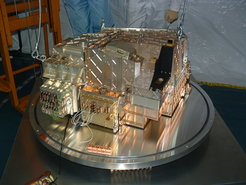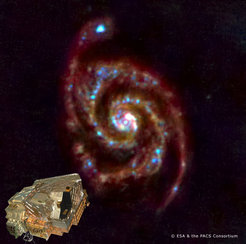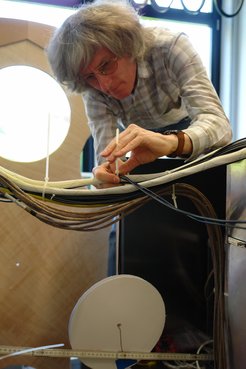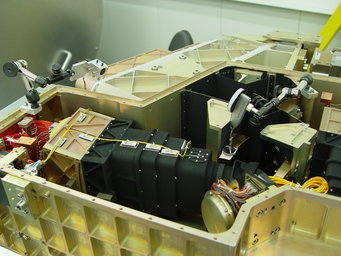Albrecht Poglitsch receives Instrumental Development Prize by the German Astronomical Society 2017

The far-infrared wavelength range is very interesting for astronomers, as UV and optical radiation is absorbed by interstellar dust and gets emitted as thermal radiation. At the same time, many important cooling lines of the interstellar gas are in this wavelength window. Observations at these wavelengths, however, are difficult because this radiation (30-300 μm) is absorbed by the Earth's atmosphere and the far infrared therefore cannot be observed with ground-based telescopes. In addition, the development of sensitive photometers and spectrometers for this range is particularly difficult. Many techniques known for optical or microwave wavelengths do not work very well if at all; there are no commercially available detectors; and the instrument including moving parts, detectors and read-out electronics has to be cooled down to a few Kelvin to keep the thermal background to a minimum.

For more than three decades, Albrecht Poglitsch established himself as one of the world’s leading experimenters in this important and challenging field of research. In autumn 1986, he joined the Max Planck Institute for Extraterrestrial Physics and built – in collaboration with UC Berkeley – the unique Fabry-Perot spectrometer FIFI, which was operating with the Kuiper Airborne Observatory from 1988 to 1995. This instrument delivered important first results on the spectroscopy of the Interstellar medium in the Milky Way and near-by galaxies.
Based on this work, Albrecht Poglitsch began developing PACS, a combination of a camera and a spectrometer („integral field spectrometer“ (IFS)) for the Herschel space telescope. This system simultaneously provides a two-dimensional image field and a spectrum, i.e. splitting light into its wavelengths. The photodetector arrays used in the PACS spectrometer are the largest and most sensitive of their kind today. For the SOFIA aircraft observatory, Albrecht Poglitsch led the development of FIFI-LS – a twin of PACS – which is now successfully operated by the German SOFIA institute.

Herschel opened its 'eyes' on 14 June 2009 and PACS (inset) obtained this image of M51, ‘the whirlpool galaxy’, for a first test observation.
The complexity of PACS, the limits on weight, volume and power resources on a space telescope, as well as the cooling system required breaking new ground in technology development. Albrecht Poglitsch's knowledge of experimenting as well as physics was indispensable to advance the mechanical and optical design far beyond previous infrared instruments. In the end, the instrument worked great: during nearly four-years of operation in space there was no significant problem.
The scientific results of PACS are impressive: the instrument was used for more than 60% of all Herschel observing time; more than 1400 publications resulted from these observations so far. The analysis with PACS spans the complete range of galaxies from the early universe and the cosmic infrared background, old and young stars and the filament structure of the interstellar medium, to protoplanetary targets and objects of our solar system, e.g. in the Kuiper Belt. The paper describing the PACS instrument (Poglitsch et al. 2010) has already been cited about 1300 times.

To prevent interference from electrically induced magnetic fields, the cabling had to be repositioned on the Herschel satellite – as Albrecht Poglitsch demonstrated in an experimental setup in the laboratory.
For his doctoral thesis on the detection of picosecond relaxations in bio-polymers with millimeter spectroscopy Albrecht Poglitsch received the Otto Hahn Medal from the Max Planck Society in 1984. The LabEx FOCUS programme of the "Service d'Astrophysique" at the IRFU/CEA in France cited him as one of the world’s most recognized infrared detection specialists with high sensitivity in 2014, and in 2016 he was awarded the Gay-Lussac Humboldt Prize by the French Higher Education and Research Ministry.
PACS instrument
PACS is an Integral Field Detector for the Herschel Space Telescope. It has been developed by a consortium of institutes led by MPE (Germany) and including UVIE (Austria); KU Leuven, CSL, IMEC (Belgium); CEA, LAM (France); MPIA (Germany); INAFIFSI/OAA/OAP/OAT, LENS, SISSA (Italy); IAC (Spain). This development has been supported by the funding agencies BMVIT (Austria), ESA-PRODEX (Belgium), CEA/CNES (France), DLR (Germany), ASI/INAF (Italy), and CICYT/MCYT (Spain).















